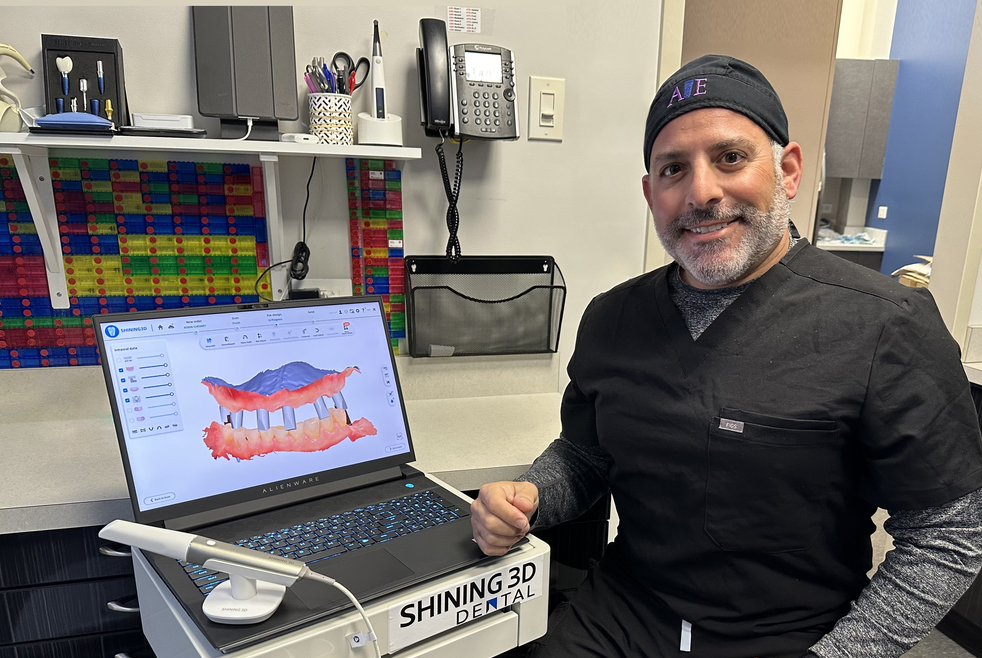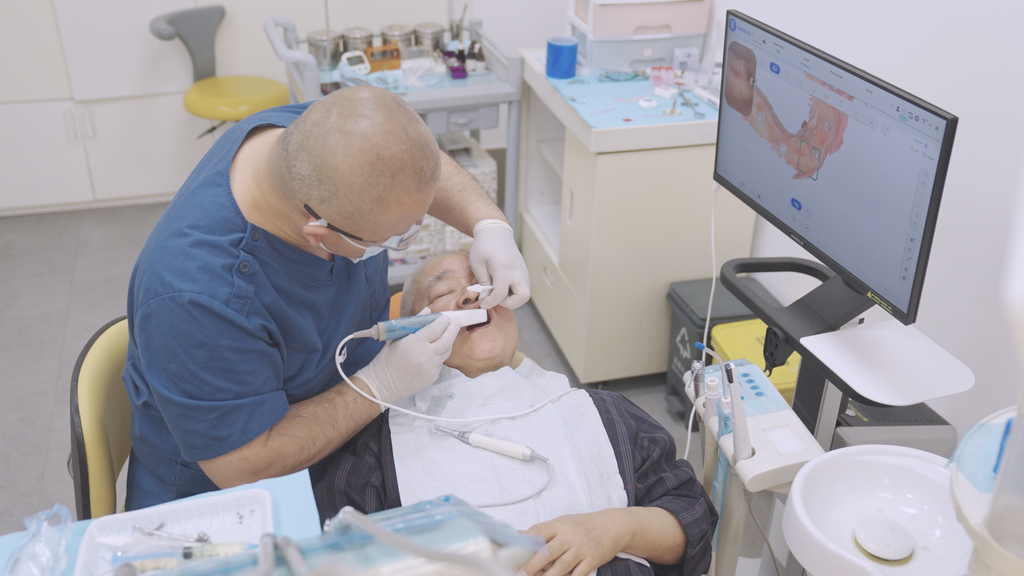Table of Contents
Is your dental clinic gradually moving to digital solutions or preparing to do so? Digital dentistry is clearly becoming a key factor in maintaining dental clinics’ competitiveness, as it offers high precision, space saving, patient comfort, and efficiency.
However, accurately capturing a full dental arch’s 3D model is a challenge. Currently, there are three technologies to obtain digital impressions: traditional intraoral scanners (IOS), extraoral photogrammetry (EPG), and intraoral photogrammetry (IPG) launched by SHINING 3D DENTAL.
If you are considering purchasing intraoral scanners for your dental clinic, IPG dental scanners can serve as an alternative to the first two. Why? It’s the ultimate “All-in-One” solution for dental clinics. This blog will compare IPG, IOS, and EPG. Keep reading.

What are IOS, EPG, and IPG?
1. IOS
An intraoral scanner (IOS) is an optical scanning device that is placed directly inside the patient’s mouth. The working principle is similar to “taking photos” inside the oral cavity. It projects specific light sources (such as laser or structured light) onto the tooth surface and simultaneously captures the deformed reflected light patterns. The reflected light is received by sensors on the probe and converted into digital signals. Then, using algorithms such as triangulation, it calculates and reconstructs a 3D digital model of teeth, gums, and other tissues in real time.

2. EPG
Extraoral photogrammetry (EPG), as the name suggests, is a technology that captures dental 3D data outside. The EPG device is a photogrammetric machine or a high-end DSLR camera, which is fixed in a position. It captures images of the patient’s teeth (with fiducial markers placed on them) from different angles and then analyzes the photographic images and electromagnetic radiation patterns to obtain precise 3D data.
Moreover, it relies on IOS to capture tissue surfaces and occlusion relationships. Factors such as improper camera settings or insufficient lighting can affect the 3D model quality.

3. IPG
Intraoral photogrammetry (IPG) is an innovative digital dental impression technology launched by SHINING 3D DENTAL. IPG combines the advantages of intraoral scanning and photogrammetry, utilizing multi-angle photogrammetry and real-time dynamic tracking technology.
Its working principle involves placing multiple high-precision coded scanbodies inside the oral cavity. During scanning, the scanner rapidly calculates the relative positions of the scanbodies based on the absolute coordinates of the coded points and the 3D coordinates of the coded points extracted by the IPG scanner, thereby capturing the positions of teeth, gums, and implants.
This approach fundamentally avoids the cumulative errors associated with traditional IOS image stitching, making the accuracy of photogrammetry up to 5μm.

IPG vs. IOS
What differences do the working principles of IPG and IOS bring to their practical applications? The most important aspects are anti-interference capability and scanning accuracy.
1. Anti-interference Capability
When acquiring digital impressions, IOS is susceptible to interference from saliva and oral bleeding. These fluids can affect the scanning light reflection and imaging, leading to inaccurate scanned data. Plus, when capturing full-arch data (such as for All-on-X implants), the posterior regions of the maxilla and mandible may be obstructed by the tongue or cheeks, resulting in incomplete impressions.
In contrast, the IPG intraoral scanner exhibits strong anti-interference capabilities. This is not only due to its working principle, which utilizes the positions of coded scanbodies to calculate implant positions, but also because it employs cap scanbodies as intermediaries to ensure precise positioning of the coded scanbodies. Both the coded scanbody and cap scanbody data are converted into CAD data, enhancing alignment accuracy.
2. Scanning Precision
Although IOS excels at capturing oral structures, its reliance on optical scanning can lead to cumulative stitching errors and alignment issues when scanning larger areas. Therefore, while it handles dentate cases with ease, its accuracy may be insufficient for complex All-on-X implants requiring full-arch scanning.
On the other hand, the IPG intraoral scanner can simultaneously capture comprehensive data of multiple implants, providing a more precise 3D model. It remains unaffected by saliva or bleeding and does not suffer from incomplete impressions due to obstructions, making it the current gold standard for All-on-X implant impressions.
IPG vs. EPG
Both IPG and EPG utilize dental photogrammetry methods, so what are the most significant differences between them?
1. Operation Steps
According to the working principles described above, EPG requires a multi-step scanning process. First, the EPG device is used to precisely scan the implants, followed by an IOS scan of the soft tissues. Finally, the data is integrated through software. This increases operational time and may lead to reduced accuracy due to data integration issues.
In contrast, IPG (intraoral photogrammetry) employs a one-step workflow that is simple and efficient. A single operation simultaneously captures the complete 3D model and spatial relationships of teeth, implants, and soft tissues. This significantly reduces both operational time and patient discomfort.
2. Convenience
EPG scanning typically requires two operators, and data integration must be handled by specialized technical personnel. Even minor mishandling may lead to deviations, affecting the final impression accuracy.
The intraoral photogrammetry device is lightweight (approximately 130g-250g) and allows single-person operation, significantly improving convenience. Its data integration is automatically completed during the scanning process, and this efficiency saves valuable time for dental clinics during busy periods.
3. Purchase Cost
There are not many manufacturers of EPG devices, resulting in high acquisition costs ranging from approximately $35,000 to $50,000. Additionally, it also requires purchasing an intraoral scanning device, making it less widely adopted outside specialized centers and advanced dental clinics.
SHINING 3D photogrammetry dental scanners cost around $20,999, offering flexibility for both dentate and edentulous cases, making them suitable for dental clinics and hospitals.

In summary, IPG is an “All-in-One” alternative to IOS and EPG. It enables the acquisition of highly precise digital impressions in a single step, significantly improving diagnostic and treatment efficiency. Intraoral photogrammetry supports single-operator use, streamlining the workflow and enhancing convenience for dentists. Moreover, the photogrammetry dental scanner is competitively priced, making it suitable for dental clinics and hospitals of various scales.
About SHINING 3D IPG Intraoral Scanners
Are you looking to upgrade your dental clinic’s digital impression solution? SHINING 3D photogrammetry dental scanners are a trusted choice.
We offer two models: the Aoralscan Elite and the Aoralscan Elite Wireless, both integrated with advanced photogrammetry dental technology, providing scanning accuracy of up to 5 μm for digital impressions. Other product details include:
- · The Aoralscan Elite (wired) weighs 124g, while the Aoralscan Elite Wireless (with battery) weighs 194g.
- · Compact and ergonomically designed for comfortable handling.
- · The wireless version utilizes Wi-Fi 6 technology for fast and stable data transmission. Its high-capacity battery supports up to 2 hours of continuous scanning.
Feel free to contact us anytime for more details about photogrammetry dentistry and to upgrade your clinic’s digital impressions!
 ENG
ENG








